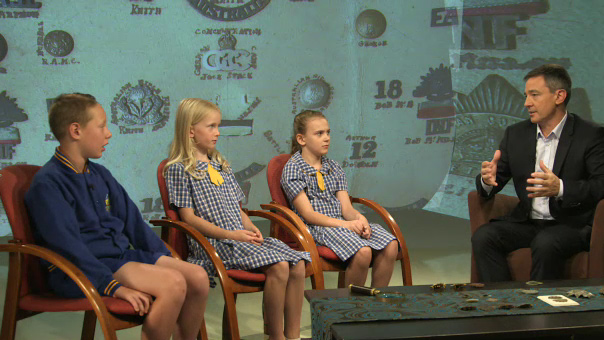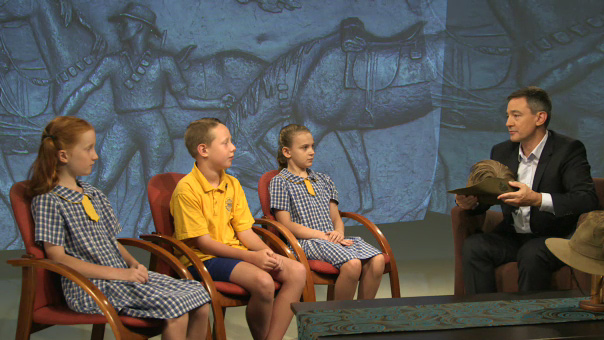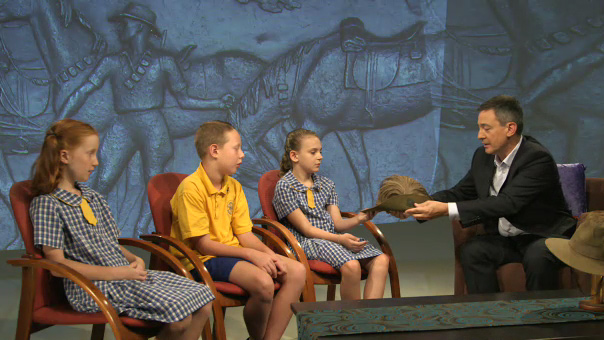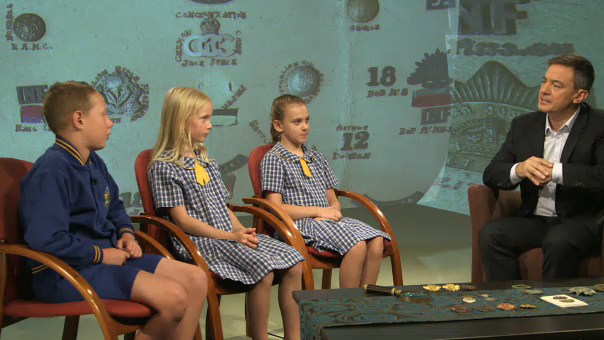Viewing guide
Look at the current Rising Sun badge, the Seventh Pattern 1991.
Where have you seen the rising sun symbol? Perhaps you have seen it:
-
on a soldier’s hat
-
at a local museum or war memorial
-
at a cemetery on the headstone of a soldier.
Think about:
-
how a soldier wearing the Rising Sun badge might feel
-
what this badge means to the public
-
why the Rising Sun badge is important.
Examine the current Rising Sun badge, the Seventh Pattern 1991. Look at the features of the badge. How do these contribute to the meaning?
Look at badges that represent groups of people.
Make a design drawing for a badge that could represent your family, class or sporting group. Before you begin consider the features of your badge.
Anzac stories is a suite of videos relating to aspects of the First World War. Rising Sun—part 2 is a Stage 2 history resource that focuses on Anzac symbols and commemoration.
In this video the senior historian from the ANZAC Memorial displays historical artefacts, Rising Sun badges, to a group of students and discusses their symbolism and importance.
This video resource addresses the following NSW Board of Studies, Teaching & Educational Standards, history Stage 2 syllabus outcomes.
A student:
-
identifies celebrations and commemorations of significance in Australia and the world (HT2-1)
-
applies skills of historical inquiry and communication
Days and weeks celebrated or commemorated in Australia (including Australia Day, ANZAC Day, Harmony Week, National Reconciliation Week, NAIDOC Week, National Sorry Day) and the importance of symbols and emblems (ACHHK063)
Students:
-
identify and describe local, state and national symbols and discuss the origins, symbolism and significance, eg the school logo, Australian and Aboriginal and Torres Strait Islander flags, coats of arms from states and Australia
-
identify important Australian celebrations and commemorations and discuss their origins and significance in society.
Brad Manera: The rising sun has been a symbol that dates from probably the 1850s, you start to see it being used in Australia, in the Australian colonies on food labels, a whole range of purposes. Indeed, there was a group that was opposed to the transportation of convicts to the eastern colonies in the 1850s. In 1853 they used the rising sun as one of their symbols. So it was a symbol that many people in Australia were familiar with by the end of the 19th century.
Lily: Why does the badge always have the sunrays on it?
Brad Manera: I think you've got to have a symbol that's really recognisable, and the rays of the rising sun were very, very distinctive. People were familiar with the image. It really made a very obvious badge. Also, I think they wanted to get away from the idea that each of the colonies used a plant or an animal in their badges. New South Wales had a waratah. Western Australia had a swan. But if they chose the rising sun, it was something that all Australians could identify with.
Cooper: Why do we need the badges?
Brad Manera: We need badges to create a sense of identity so that we all know which team we're on. And this symbol of the rising sun became so powerful that soldiers ended up adapting it into badges that they sent home to those they loved on the other side of the world while they were off at the war. And so, you've got the standard Rising Sun military badge, but then there were also a whole range of modified versions of the Rising Sun being used by local jewellers, indeed, being shaped by the soldiers themselves, so that they could send them home so that people back at home would know that they were thinking of them. It's a really strong symbol. It's a really unifying emblem.
Isabella: Is it the same today as it was in the beginning?
Brad Manera: It's very recognisably similar, but the badge has changed. Fashion, changing politics, changing use of our army has meant that the badges have changed. This is a Rising Sun badge that's being worn today by our young men and women serving overseas. You can see it's on fabric, and in the background... This is called Disruptive Pattern. It's camouflage. And the Rising Sun symbol has been embroidered on it. You can see it's got a queen's crown and it reads ‘The Australian Army’.
Lily: Why is the badge important today?
Brad Manera: We need the badge today because it's a symbol, the way it has been for over 100 years. It unifies our young men and women in uniform whether they're serving at home or overseas. I think the badge today gives them a sense of tradition that dates back to the turn of the 20th century. So, the Rising Sun is important because it's been around for over 100 years, and I think it may last for many hundreds of years to come as the symbol for our soldiers in uniform.
Before student viewing
Discuss where students have seen the rising sun symbol. Perhaps someone in the community has a Rising Sun badge that students could view or perhaps the local War memorial features the rising sun symbol.
During student viewing
Think about what the Rising Sun badge would mean to an Australian soldier working in another country. Why would the badge be important to them?
After student viewing
Assist students to identify a group for whom they will design a badge. Before they begin discuss:
-
who the badge will be important to
-
what aspects of the group should be represented on the badge
-
how the aspects will be represented.
Resources to support learning activities in Rising Sun badge—part 2.
Although this website is copyright NSW Department of Education, we would like to acknowledge the sources for images.



